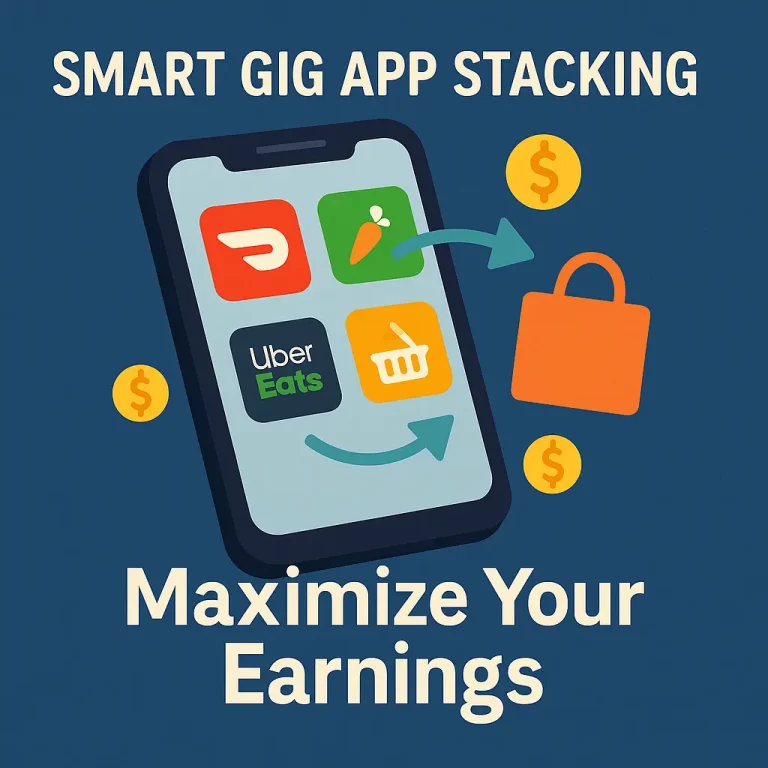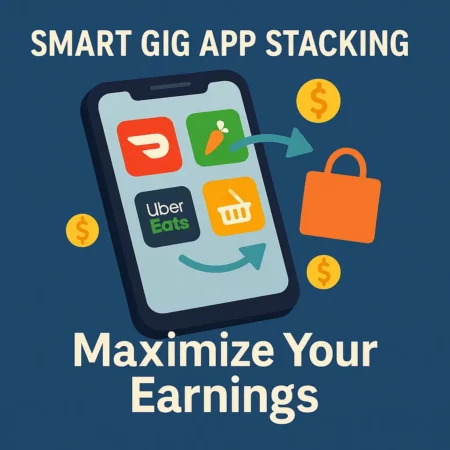Stacking gig apps is one of the smartest ways to boost your daily earnings without picking up extra hours. Whether you’re delivering food, shopping for groceries, or driving passengers, there’s often downtime between orders. Instead of waiting around, savvy gig workers are learning how to run multiple apps at once to fill those gaps and earn more per hour.
But there’s a catch, without the right strategy, stacking can quickly lead to stress, fatigue, and even lower earnings. If you’ve ever ended a long day wondering where the time (and money) went, you’re not alone.
In this article, we’ll break down how to stack apps the right way. You’ll learn which gig apps work best together, how to schedule your day for maximum efficiency, and what tools can help you track your time, mileage, and income. Most importantly, we’ll show you how to avoid burnout while still hitting your income goals.
Let’s get into the smart hustle strategies that actually work.
Why Stacking Apps = More Freedom and More Risk
At first glance, stacking apps feels like the ultimate gig worker hack. You’re not tied to one platform. You can accept the best offers, skip the slow ones, and take control of your schedule. If DoorDash slows down, you can switch to Instacart. If both are quiet, Uber Eats might pick up the slack. That kind of flexibility is what draws people into the gig economy in the first place.
The potential for higher income is real. By layering apps that complement each other, you can reduce downtime, increase completed gigs, and take advantage of peak bonuses across platforms. Many experienced workers even hit $200 or more in a single day when stacking apps with intention.
Still, flexibility comes with trade-offs.
Running multiple apps means constantly switching between platforms, tracking orders, and managing overlapping pickups. It requires sharp focus and solid time management. Without a system, you might miss deliveries, make mistakes, or just feel completely drained by the end of the day.
You’re also more likely to experience app glitches, mixed-up routes, or exhaustion from trying to do too much. That’s why smart stacking is essential.
Let’s look at which gig app combos work best together and why some pairings are smoother than others.
The Best App Stacking Combos (Delivery, Shopping, Driving)
Not all apps play well together. Some overlap naturally, while others create more stress than they’re worth. The key is finding apps that complement each other’s timing, location patterns, and order types.
Here are the top stacking combinations that real gig workers rely on to stay efficient and profitable:
DoorDash + Instacart
This is one of the most popular stacking combos for a reason. Instacart orders usually take longer and involve shopping, which creates natural gaps. You can often run DoorDash in the background and accept quick food deliveries while waiting for Instacart batches to be ready or between stores. It works best during peak meal hours and mid-day shopping rushes.
Shipt + Uber Eats
Shipt tends to offer more flexible delivery windows, which allows you to schedule orders ahead of time. This creates space to accept on-demand Uber Eats orders in between. Just be mindful of the delivery zones so you don’t double-book in different areas.
Uber + Lyft
This combo works well for rideshare drivers who are aiming to stay consistently busy. You can run both apps at once and accept whichever trip pays better or is closer. It’s important to toggle availability or pause one app when you accept a ride to avoid double-booking.
Grubhub + DoorDash
These apps both specialize in restaurant delivery, and many drivers use them interchangeably. The trick is to avoid overlapping pickups unless both orders are going in the same direction. Grubhub is often slower, which makes it a good secondary app while running DoorDash more actively.
For more insight into which apps pay the best, check out our detailed breakdown of the highest-paying gig apps and the top delivery gig apps ranked for 2025.
Best Gig App Stacking Combos
| Combo | Primary Strength | Why It Works |
|---|---|---|
| DoorDash + Instacart | Delivery + Grocery Shopping | Fill downtime between Instacart batches with quick food deliveries |
| Shipt + Uber Eats | Scheduled + On-Demand Flexibility | Shipt’s flexible delivery windows pair well with fast Uber Eats orders |
| Uber + Lyft | Rideshare Efficiency | Accept the best-paying trip and pause the other app to avoid double booking |
| Grubhub + DoorDash | Dual Delivery Coverage | Use Grubhub as a backup while actively running DoorDash for more consistent flow |
How to Schedule Stacking Without Burning Out
App stacking sounds great in theory, but without a clear schedule, it can quickly lead to mental fatigue, missed orders, and a calendar full of chaos. The goal isn’t to stay busy every second, it’s to be strategic about when and how you work.
Here’s how to schedule your stacking routine in a way that maximizes income while protecting your time and energy.
Know Your Peak Hours
Every app has its own rhythm. Food delivery apps like DoorDash and Uber Eats peak during lunch and dinner hours, while Instacart and Shipt are busiest in the late mornings and weekends. Use this to your advantage by assigning primary and secondary apps based on the time of day.
For example:
Morning to midday: Focus on shopping apps like Instacart or Shipt.
Lunch (11 AM – 2 PM): Add food delivery apps like DoorDash or Uber Eats.
Afternoons: Use this slower period for rest, errands, or tracking expenses.
Dinner rush (5 PM – 8 PM): Shift back to high-volume food delivery apps.
Start With One Primary App Per Block
Trying to actively run three apps at once is a recipe for burnout. Instead, treat one app as your “anchor” during each time block and keep one or two others on in the background to fill gaps. This gives you more control and fewer chances to overcommit.
Build in Short Breaks
When you stack multiple apps, it’s easy to skip breaks and keep chasing orders. Resist that urge. A quick 15-minute break every few hours can reset your focus, give your body a rest, and help prevent decision fatigue.
Track Your Energy, Not Just Your Income
Many gig workers obsess over dollars per hour but ignore how drained they feel at the end of the day. Watch for signs of burnout like irritability, poor decision-making, or skipping meals. If you’re running yourself into the ground just to hit a daily goal, it’s time to reassess your schedule.
Scheduling smarter helps you stay consistent, which is far more valuable than one or two “grind it out” days each week.
In the next section, we’ll give you a simple daily routine template you can customize based on your apps, goals, and availability.
Daily Routine Template for Gig Workers
A solid routine can turn a chaotic day into a predictable, profitable one. Whether you’re working full-time or stacking apps around another job, having a plan helps reduce stress, conserve energy, and keep your earnings consistent.
Below is a flexible daily template that you can adapt to your own schedule and preferred apps.
🕗 8:00 AM – 10:30 AM: Morning Shopping Rush
Primary App: Instacart or Shipt
Secondary App: Uber Eats (watch for nearby breakfast orders)
This is when grocery orders start picking up. Knock out a few shops while traffic is light and parking is easier.
🕙 10:30 AM – 11:00 AM: Break or Transit
Use this time to rest, grab a snack, or drive toward a high-demand lunch area.
Avoid going full speed all day, breaks will keep you sharp and prevent fatigue.
🕛 11:00 AM – 2:00 PM: Lunch Delivery Peak
Primary App: DoorDash or Uber Eats
Secondary App: Grubhub or Skipcart
This is one of the highest-earning blocks of the day. Focus on short-distance, high-tip orders and stack when routes align.
🕑 2:00 PM – 4:00 PM: Low Activity Buffer
Take a longer break or handle admin tasks like tracking your mileage, organizing receipts, or reviewing your income.
You can also use this downtime to explore gig apps that pay daily or try a lower-effort app for passive income.
🕓 4:00 PM – 8:00 PM: Dinner Rush
Primary App: Uber Eats or DoorDash
Secondary App: Roadie or Spark (if local Walmart deliveries are available)
This is your second big earning window. Use strategies like zone targeting or batch stacking when possible.
🕗 8:00 PM – 9:00 PM: Final Orders or Wind Down
Take a few more deliveries if you’re still in a good zone and feeling energized.
Otherwise, use this time to wind down, stretch, and review your daily numbers.
This structure allows for high productivity while leaving room to recharge. Over time, you’ll figure out which zones and apps perform best in your area. From there, you can refine your schedule and stack smarter, not harder.
Next, let’s look at the tools that can help you manage all of this without losing track of your mileage, time, or profits.
The Tools You Need to Track Mileage, Income, and Time
Stacking gig apps adds complexity to your workday. You’re managing multiple platforms, routes, orders, and payouts. Without the right tools, it’s easy to lose track of where your time and money are really going. The good news is that several apps are built specifically to help gig workers stay organized and profitable.
Here are the best tools to streamline your workflow and protect your earnings.
Solo
Solo is one of the most powerful tools for gig workers who stack multiple apps. It automatically tracks your earnings across platforms, analyzes your performance, and even predicts how much you’ll make based on historical trends in your city. It also includes scheduling tools, mileage tracking, and tax estimates. Many users report a boost in efficiency within the first week of using it.
Everlance
Everlance is ideal for mileage tracking, which is crucial for maximizing your tax deductions. The app runs in the background, logs all your trips, and lets you separate personal and business drives with a quick swipe. You can also upload receipts, export IRS-compliant reports, and categorize expenses easily.
Gridwise
Gridwise is another all-in-one tracker built for rideshare and delivery drivers. It tracks mileage, earnings, and time spent working, plus offers airport alerts and city-specific data to help you plan your day. It’s especially helpful if you stack rideshare apps like Uber and Lyft.
Google Sheets or Notion (Manual Option)
If you prefer a DIY approach, a simple spreadsheet in Google Sheets or a custom dashboard in Notion can work. You’ll need to log trips, income, and expenses manually, but it gives you full control and visibility. This option is best for those who already have strong habits around daily tracking.
Using these tools can save you hours of guesswork each week and hundreds (or even thousands) in unclaimed mileage and deductions each year. Tracking isn’t just about taxes it’s about making smarter, data-backed decisions about your time.
Best Tools for Tracking Gig Work
| Tool | Best For | Key Features | Link |
|---|---|---|---|
| Solo | All-in-one income tracking | Earnings predictions, income tracking, mileage, tax estimates | Visit Solo |
| Everlance | Automatic mileage tracking | Trip logging, receipt uploads, IRS-ready reports, expense categorization | Visit Everlance |
| Gridwise | Rideshare and delivery insights | Mileage tracking, airport alerts, multi-app income overview | Visit Gridwise |
| Google Sheets / Notion | Manual custom tracking | Full customization, free to use, track whatever matters to you | N/A |
How Much Can You Realistically Earn?
Stacking gig apps can absolutely increase your daily income, but how much you earn depends on several key factors: your city, the apps you choose, your strategy, and how efficiently you stack your time.
Here’s a general breakdown of what you can expect:
Typical Daily Earnings (Based on Full-Time Gig Workers)
| Strategy | Estimated Daily Earnings | Notes |
|---|---|---|
| Single App (No Stacking) | $80 – $120 | Based on average hourly rates from DoorDash, Uber Eats, or Instacart alone |
| Smart Stacking (2–3 Apps) | $130 – $200+ | Higher earnings with optimized schedules and zone planning |
| Aggressive Multi-App Stacking | $200 – $300+ | Possible in high-demand cities but often leads to burnout if unsustainable |
These numbers are based on real-world input from gig workers on platforms like Reddit’s r/doordash, r/InstacartShoppers, and Gig Economy subreddits, as well as data compiled by apps like Solo and Gridwise.
Some of the top performers we’ve studied focus on a mix of delivery and shopping gigs, stack apps in the same zones, and make use of incentive bonuses and peak pay windows. If you’re still deciding which apps have the best earning potential in your area, our guide on which gig apps pay the most offers a side-by-side comparison.
While it’s possible to hit big numbers, consistency and sustainability matter more than one-off high days. A smart stacking strategy focuses on average daily income over time, not just short bursts.
Let’s wrap up with a few final thoughts to keep you focused on the long game.

Final Thoughts: Smart Hustle > Busy Hustle
In the gig economy, it’s tempting to think that working harder always means earning more. But the real winners are the ones who learn how to work smarter. Stacking gig apps isn’t just about keeping busy, it’s about being intentional with your time, energy, and effort.
When you choose the right app combinations, plan your schedule around peak hours, and use tools to track performance, you create a system that supports your goals instead of draining you. This is how gig workers stay consistent, avoid burnout, and build daily income they can count on.
You don’t need to chase every order or run every app all day. You need a strategy that matches your goals. Whether your target is $100 per day or a full-time income, a smart stacking routine makes it possible.
And if you’re ready to turn that income into something bigger, stay tuned for our upcoming 30-Day Monetization Map, where we’ll show you exactly how to take your gig earnings and stack them into something more long-term.
Until then, focus on building a routine that works for you and not one that runs you into the ground.









